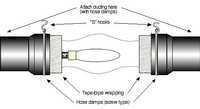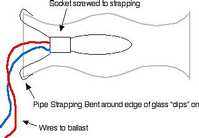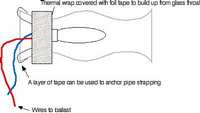GrowFAQ:
How do I build my own Cool Tube?
| Added by:
snoofer Last edited by:
10k Viewed: 698 times |
Rated by 43 users:
8.13/10 |

Original Concept Credit: johnstone, NIMBY
Written by: Don'tTreadOnMe
Additional
info by: sanclem
Compiled & edited by:
Smokey D Dope
Configuration
This type of fixture
is very versatile. There are many different ways it can
be configured:
*hanging or mounted on a chamber
wall
*open-ended drawing air from the grow or ducted
to a separate intake
*passively or actively cooled
Tools Needed:
*Power drill with 1/8"
or 3/16" drill bit
*4.25" hole saw
*pop rivet
gun (optional)
*flat head and Phillips head screw
drivers
Materials:
Keep in mind that the full list of materials you
will need depends on the type of glass you get and the
configuration you're looking to build. Here's the
materials list with some pictures and approximate
pricing:
$3.99-- Glass, either 4" Pyrex tube
(approx. 12" long, 4 diameter) or "hurricane" lamp
glass ($3.99 at Hobby Lobby, is 11 3/4" long and 4 5/8")
$2.99-- 4" H/C venting starter collar
$4.50-- 5" to 4" venting pipe reducer (for use with
hurricane glass only)
$3.00-7.00-- High-temp foil
tape
$5.00-- Thermal pipe wrap (looks like woven
fiberglass tape with no adhesive)
$8.00-- 4"
aluminum "dryer" ducting (hanging configuration)
$2.00-- 1/2 wood screws (box wall mount only)
$3.00-- pop rivets or small sheet metal screws
4"
(dryer ducting and/or Pyrex tube only) and/or 5"
(hurricane glass only) hose clamps
"S" hooks (for
hanging)
a. Hurricane glass tube

When working with the hurricane
glass "chimney," the irregular shape needs to be
overcome so that it can be attached it to a reducer
collar that will make up one end of the fixture. You may
attach a reducer collar to a single end if you want an
open ended design, or you can attach one to each end if
you will be running ducting to both intake and exhaust
ports.
 The graphics concentrate on
the exhaust end to which the bulb socket is also
anchored. On this end of the glass (at the narrow
"throat") numerous wraps of thermal pipe wrapping are
wound around the glass and secured with a couple of
wrappings of foil duct tape. The wrapping should build
up the throat to the same diameter as the opening in the
glass - where it snugly fits inside the larger end of
the reducer. The graphics concentrate on
the exhaust end to which the bulb socket is also
anchored. On this end of the glass (at the narrow
"throat") numerous wraps of thermal pipe wrapping are
wound around the glass and secured with a couple of
wrappings of foil duct tape. The wrapping should build
up the throat to the same diameter as the opening in the
glass - where it snugly fits inside the larger end of
the reducer.
 This will allow us to use a 5" hose
clamp to secure the edge of the reducer collar to this
tape wrapped "cushion." (Note: you can use foil tape
alone for building this "cushion" but the thermal
wrapping makes for a neater seal, and is less
susceptible to heat. Also, if a hose clamp isn't
available, the reducer can be secured to the glass with
foil tape. This will allow us to use a 5" hose
clamp to secure the edge of the reducer collar to this
tape wrapped "cushion." (Note: you can use foil tape
alone for building this "cushion" but the thermal
wrapping makes for a neater seal, and is less
susceptible to heat. Also, if a hose clamp isn't
available, the reducer can be secured to the glass with
foil tape.
If you use a hose clamp, you will
need to make some 1" slits in the edge of the reducer
collar the glass fits in to allow the hose clamp to
compress it enough to hold the glass securely)
Mounting the socket inside the tube
 In the graphic, a length of pipe
strapping bent in a "U" shape is used to hold the socket
far enough inside the glass to place the bulb roughly in
the middle of the glass. This glass, $3.99 at Hobby
Lobby, is 11 3/4" long and 4 5/8" at each end. Notice
this glass is symmetrical. Don't try to use the
asymmetrical hurricane lamp "chimney's" available at
Lowe's or HD; they're too small and aren't shaped in a
way that permits good air flow. In the graphic, a length of pipe
strapping bent in a "U" shape is used to hold the socket
far enough inside the glass to place the bulb roughly in
the middle of the glass. This glass, $3.99 at Hobby
Lobby, is 11 3/4" long and 4 5/8" at each end. Notice
this glass is symmetrical. Don't try to use the
asymmetrical hurricane lamp "chimney's" available at
Lowe's or HD; they're too small and aren't shaped in a
way that permits good air flow.
The socket is
either screwed or pop riveted to the bottom of the pipe
strap "U." My light was made from a 150w HPS security
light which used a "medium" base socket; this socket has
two little screws in it that more or less lined up with
the holes in the strapping.
As for the mogul
base sockets used with bigger lamps, I don't know what
they have on the bottom of them so you may have to
improvise a solution for mounting them. The ends of the
strap are bent around to "clip" over the edge of the
glass and then secured with a couple of wrappings of
foil tape. If you'd like, a more permanent mount can be
had by drilling a couple of small holes in the tapered
throat of the reducer and attaching the ends of the
strap with a couple of pop rivets.
Running
the wires
 The wires from the socket can be either
run through your 4" ducting which will attach to the
other end of the reducer or you can drill a hole in the
tapered part of the reducer to run the wire out of the
fixture to the ballast. The wires from the socket can be either
run through your 4" ducting which will attach to the
other end of the reducer or you can drill a hole in the
tapered part of the reducer to run the wire out of the
fixture to the ballast.
Here's how I actually
have it done in my box. There's no venting, it just
mounts to a 4.25" hole in the side of my flowering
chamber via a starter collar which fits snugly inside
the 4" side of the reducer collar. I've got them held
together with four pop rivets for a permanent
connection. The tabbed end of the starter collar fits
into the hole where the tabs are bent around the edge of
the hole and anchored with wood screw to the box wall.
(In my box, on the other side of this wall is my utility
room with a 4" 115cfm computer case fan sucking out the
back of it.)
One could just as easily connect
another reducer collar onto the other end of the glass
exactly as the first side was with "S" hooks for hanging
from above. This fixture could then have both intake and
exhaust from outside the box.
Originally this is
what I would have preferred to have, but as my flowering
chamber is only 2'Dx2'Wx3'H, the wall mount actually did
better for me.
b. Pyrex baking tube
(NIMBY)
"Using a Pyrex (borosilicate glass) tube obtained from a
glass blowing supply house or using a "Bake a Round"
(eBay had a dozen for sale the last time I checked) one
utilizes either one or two (pictured) 4" starter collars
instead of the 5" to 4" reducer collars. They are 14"
long and 3.75" in diameter."

"I stretched the aluminum
ducting out and measured 16". I then snipped the metal
"ribs" and cut the ducting open. The glass tube will now
just drop into the long run of ducting. The electrial
wires run to the remote ballast through the intake part
of the duct (exhaust could also be used depending upon
the location of the ballast). I measured 2" from each
side of my original cut and snipped the metal ribs again
but this time didn't cut the aluminum foil. This allows
me to open the ducting up like a "wing"."

A couple of wraps of pipe
wrap sealed with foil tape on each end you want to put a
collar on should be used to keep from biting the metal
directly into glass with the hose clamp (pictured). The
socket is mounted inside the tube with pipe strapping
just as in the hurricane style fixture. It can either be
"clipped" and taped over the edge of the glass or
better, pop riveted to the inside of the starter collar.
Simply stick the glass inside the end of the
starter collar an inch or so past the bottom of the tabs
to measure how far in to drill two holes 180 degrees
apart, then use two pop rivets to attach the strapping
A note about pipe strapping: don't get
the thin wimpy stuff. Get the thicker heavy-duty
strapping. The heavy stuff is still relatively easy to
bend but holds it's shape better and will hold the bulb
and socket straight without sagging. At Home Depot they
even have some copper pipe strapping (also known as
pipe tape" or pipe hanger) that is quite stiff.
Ventilation Performance
There are
many different ventilation options available, since
standard household ducting is used in the construction
of the fixture. For those folks with bigger boxes or
rooms, ducting in and out, "inline" duct fans are
probably the best option.
For my little
NewGanjaBoy-style setup, using the Hurricane fixture as
part of the ventilation system of my box, a 115cfm
computer fan does the trick. As for actual performance
specs for different blowers/fans and light wattages, I'm
afraid you'll have to experiment. Here's mine just to
give an example:
Box:
-NewGanjaBoy-style three chambered box
-4 20w
flouros in the mother chamber
-150w security HPS in
the flowering chamber in original metal fixture with
holes drilled in the top
Ventilation before
Cool Tube installed:
-115cfm fan exhausting box
-4"x8" intake port in the bottom of the veg chamber
-Two 2' runs of 1.5" PVC pulling air through the
wall between veg and flowering chambers
-Two 1' runs
of 1.5" PVC pulling air from over the HPS fixture into
the utility room where it's exhausting out the back.
Ventilation after Cool Tube installed:
-Two PVC runs between flowering chamber and utility
room replaced with Hurricane Cool tube fixture
-ballast moved to utility room and housed in the
original security light casing
-everything else is
the same
Temps before Cool Tube mod:
Ambient temp: 80F
Flowering chamber 1 hour
after HPS fires up: 95F (in direct light)
Flowering
chamber 6-12 hours after HPS fires up: 100-105+F
(ouch!!)
Temps after Cool Tube Mod:
Ambient temp: 80F
Flowering chamber 1 hour
after HPS fires up: 85F (in direct light)
Flowering
chamber 6-12 hours after HPS fires up: 90F (in direct
light)
SAFETY NOTICE:
Please note
that the wire to the bulb base must be a high temp
fiberglass type, or the heat will eat up the wire and
cause a running short. The thermal tape is a fiberglass
electrical tape from most hardware stores. High temp
fiberglass wrapped wire is available at any hardware or
electrical store. It is imperative that you use it, as a
smoking ballast is a real bummer to relight.
|
| Last modified: 03:57 - Feb 21,
2003 |
| |
faq:1432 "How do I build my
own Cool
Tube?" | | |